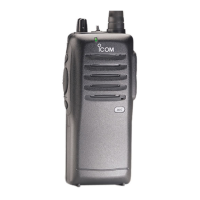
Do you have a question about the Icom IC-F11 and is the answer not in the manual?
| Brand | Icom |
|---|---|
| Model | IC-F11 |
| Category | Transceiver |
| Language | English |
Radio classified for occupational use, emphasizing awareness of hazards and minimization.
Details compliance with FCC RF exposure limits for occupational use and relevant standards.
Guidelines to ensure RF exposure stays within FCC allowable limits for occupational use.
Addresses potential RF interference from the radio and advises avoiding sensitive areas.
Describes the physical interface elements including channel selector, volume, PTT, and jacks.
Explains the meaning of the TX/RX indicator LED states for various transmission and reception conditions.
Step-by-step instructions on how to safely replace the battery pack.
Critical safety warnings regarding battery handling, shorting, incineration, and water immersion.
Provides information on battery recycling options available in the United States.
Instructions for rapid charging battery packs using the optional BC-144 charger.
Details on how to correctly combine charging spacers for optimal adapter fit.
Instructions for rapid charging up to six battery packs simultaneously with the BC-121.
Instructions for regular charging battery packs using the optional BC-146 charger.
Key notes on initial charging, temperature range, and proper charger usage.
Information on battery pack life expectancy and when a new pack is needed.
Instructions for using the optional battery case with AA alkaline batteries.
Warnings related to using alkaline batteries in the optional case, including matching and handling.
Introduction to programmable function names and how specific switches activate them.
Instructions on how to lock and unlock programmable keys to prevent accidental changes.
Procedure for selecting a pre-programmed priority channel on demand.
How to use the scan function to search pre-programmed channels for signals.
Method for switching between high and low power output levels for a channel.
How to use the monitor function to check channel status (busy or not).
Explanation of the talk around function, changing duplex to simplex channels.
Functionality to send pre-programmed DTMF codes for control or squelch opening.
Procedure to quickly send emergency ID and signals to a base station.
Temporarily select memory channels CH1 through CH4 using specific keys.
Eliminates unwanted audio using a system similar to CTCSS tone squelch.
Basic steps for receiving calls and transmitting messages on a selected channel.
Steps involved in tone signalling and selective calling for specific station communication.
Information on the Time-Out Timer and Penalty Timer functions affecting transmissions.
Step-by-step guide for transferring programmed data between transceivers.
Procedure for cloning data from a PC using the CS-F11 cloning software.
Warning about potential cloning errors and data loss from imprudent operations.
List and descriptions of available optional battery packs for extended use.
List and descriptions of optional desktop and multi-chargers for battery packs.
Overview of other optional accessories like speaker-microphones, headsets, and adapters.
